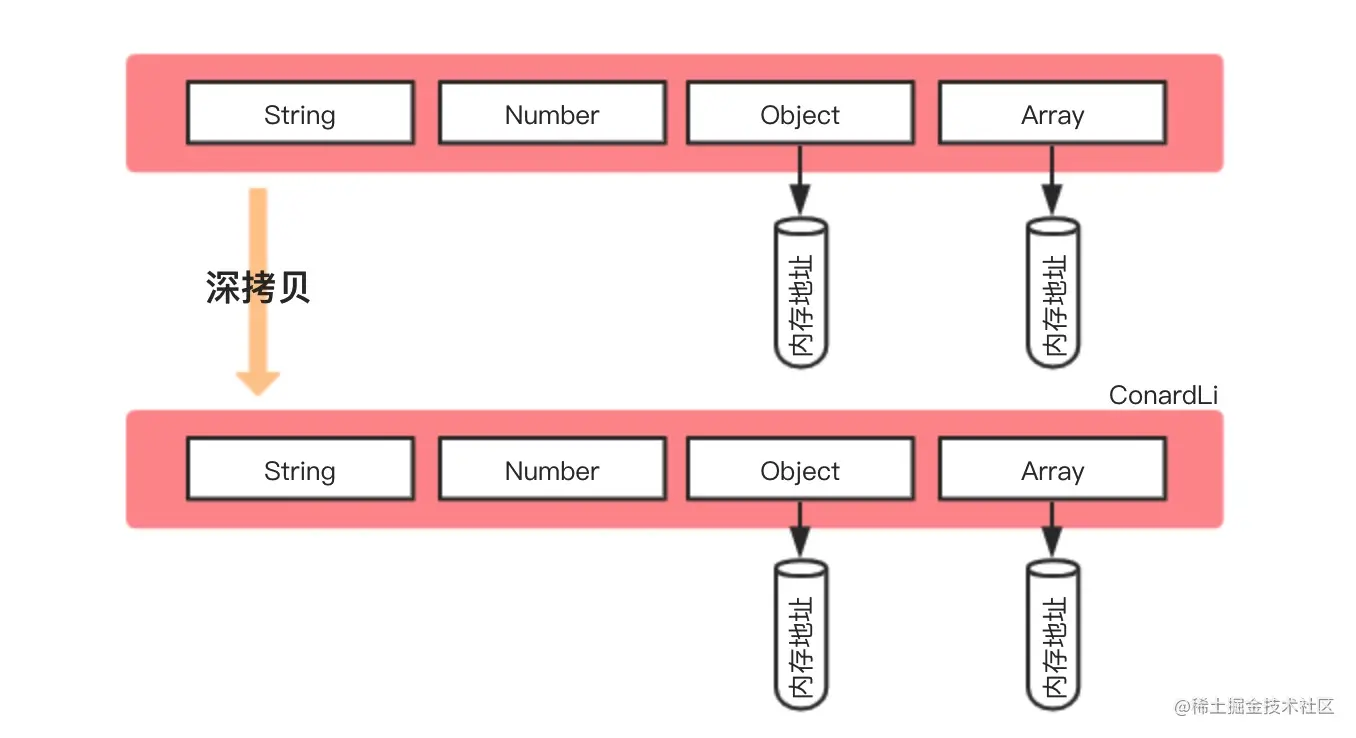
引用类型的拷贝
回顾一下引用类型的特点
- 因为
JavaScript不允许直接访问内存位置(即不能直接操作引用类型所在的内存空间),所以引用类型在 栈内存 中存储的是地址(即内存指针),而引用类型中的数据(方法或属性)是存储在 堆内存 中 - 保存引用类型的变量是 按引用 (by reference) 访问 ,当我们访问和操作一个对象时,实际上操作的是对该对象的引用而非实际的对象本身
- 复制引用类型时只会复制内存指针
因此我们在开发过程中对引用类型进行拷贝并修改时,便需要根据场景需求注意对原本数据的影响。
TIP:以引用类型中的对象为代表举 🌰
浅拷贝

图片来源于如何写出一个惊艳面试官的深拷贝?
浅拷贝是创建一个新对象,这个对象有着原始对象属性值的一份精确拷贝:基本类型拷贝的是值,引用类型拷贝的就是内存地址;所以当我们操作新对象中的引用类型时会影响源对象
Object.assign()
js
const obj1 = {
name: 'maomao',
props: { a: 1 },
}
const obj2 = Object.assign({}, obj1)
obj2.name = '茂茂'
obj2.props.a++
obj1 // { name: 'maomao', props: { a: 2 } }
obj2 // { name: '茂茂', props: { a: 2 } }Array.prototype.concat()
js
const arr1 = [1, 2, 3, [4, 5]]
const arr2 = arr1.concat()
arr2[0] = 'arr2'
arr2[3][0] = 'arr2'
arr1 // [1, 2, 3, ['arr2', 5]];
arr2 // ['arr2', 2, 3, ['arr2', 5]];Array.prototype.slice()
js
const arr1 = [1, 2, 3, [4, 5]]
const arr2 = arr1.slice()
arr2[0] = 'arr2'
arr2[3][0] = 'arr2'
arr1 // [1, 2, 3, ['arr2', 5]];
arr2 // ['arr2', 2, 3, ['arr2', 5]];ES6 扩展运算符
js
/* 对象 */
const obj1 = {
name: 'maomao',
props: { a: 1 },
}
const obj2 = { ...obj1 }
obj2.name = '茂茂'
obj2.props.a++
obj1 // { name: 'maomao', props: { a: 2 } }
obj2 // { name: '茂茂', props: { a: 2 } }
/* 数组 */
const arr1 = [1, 2, 3, [4, 5]]
const arr2 = [...arr1]
arr2[0] = 'arr2'
arr2[3][0] = 'arr2'
arr1 // [1, 2, 3, ['arr2', 5]];
arr2 // ['arr2', 2, 3, ['arr2', 5]];深拷贝

深拷贝是将一个对象从内存中完整的拷贝一份出来,即从堆内存中开辟一个新的区域存放新对象,所以修改新对象不会影响原对象
JSON.parse(JSON.stringify())
js
const obj1 = {
name: 'maomao',
props: { a: 1 },
}
const obj2 = JSON.parse(JSON.stringify(obj1))
obj2.name = '茂茂'
obj2.props.a++
obj1 // { name: 'maomao', props: { a: 1 } }
obj2 // { name: '茂茂', props: { a: 2 } }JSON.parse(JSON.stringify()) 存在明显的弊端:
- 只能序列化对象的可枚举的自有属性
undefined、Symbol、任意函数将被忽略NaN、Infinity、-Infinity将被当成null处理RegExp、Error、Set、Map等特殊对象,仅会序列化可枚举的属性(一般情况下即为空对象)Date类型,转换后会调用toJSON转为字符串类型- 循环引用的对象将报错
js
const map = new Map()
map.set(1, 2) // Map: 0: {1 => 2}
const obj1 = {
a: undefined,
b: null,
c: Symbol(),
d: NaN,
e: Infinity,
f: -Infinity,
g: map,
h: new Date(),
i: () => {},
}
Object.defineProperty(obj1, 'j', {
value: 'string',
})
const obj2 = JSON.parse(JSON.stringify(obj1))
/** 源对象 obj1
{
a: undefined,
b: null,
c: Symbol(),
d: NaN,
e: Infinity,
f: -Infinity,
g: Map(1) {1 => 2}
h: Fri Mar 10 2023 22:41:08 GMT+0800 (中国标准时间) {},
i: () => {},
j: 'string'
}
**/
/** 新对象 obj2
{
b: null,
d: null,
e: null,
f: null,
g: {},
h: '2023-03-10T14:41:08.110Z'
}
**/structuredClone
HTML规范标准的 Web API
js
const original = { name: 'MDN' }
original.itself = original
const clone = structuredClone(original)
console.assert(clone !== original) // the objects are not the same (not same identity)
console.assert(clone.name === 'MDN') // they do have the same values
console.assert(clone.itself === clone) // and the circular reference is preservedHTML 规范的标准提案,使用结构化克隆算法将给定的值进行深拷贝,支持循环引用。还可以使用 structuredClone(value, { transfer }) 调用方式使可转移对象仅被传递,不被克隆(直接移动源数据)
注意点
尽管作为规范标准实现的 Web API,但目前兼容性还是个巨大的问题,同时仍有其他不足:
- 无法拷贝对象的原型链
- 无法拷贝函数
- 不支持
Error数据类型
MessageChannel
vue.nextTick源码曾使用的Web API,在了解这个API时发现可以用于深拷贝
js
function cloneUsingChannel(obj) {
return new Promise((resolve) => {
const channel = new MessageChannel()
channel.port1.onmessage = (e) => resolve(e.data)
channel.port2.postMessage(obj)
})
}但该方法存在一个缺陷,当拷贝对象带有函数属性时,将抛出错误:
js
const obj1 = {
fn: function () {},
}
const obj2 = cloneUsingChannel(obj1)
// Uncaught (in promise) DOMException: Failed to execute 'postMessage' on 'MessagePort': function () {} could not be cloned.JQuery.extend()
js
import $ from 'jquery'
const obj2 = $.extend(true, {}, obj1)lodash.cloneDeep
js
import { cloneDeep } from 'lodash-es'
const obj2 = cloneDeep(obj1)
